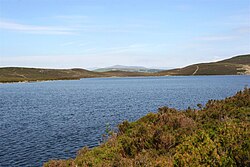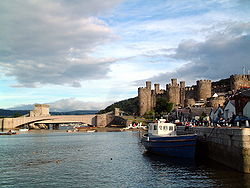River Conwy

The River Conwy (Welsh: Afon Conwy) or Conway is the fair river which marks for almost iits whole course the border between Caernfonshire and Denbighshire and waters the Conwy Valley from the mountains to the sea in Conwy Bay.
The Conwy is 27 miles long. Its source is on the Migneint moor where a number of small streams flow into Llyn Conwy, from which the river issues and flows in a generally northern direction. It is soon joined by two tributaries, the rivers Machno and Lledr before reaching Betws-y-Coed, where it is also joined by the River Llugwy.
From Betws-y-Coed the river continues to flow north through Llanrwst, Trefriw (where it is joined by the River Crafnant) and Dolgarrog (where it is joined by Afon Porth-llwyd and Afon Ddu) before reaching Conwy Bay at Conwy. During spring tides the river is tidal as far as Llanrwst.




The river changes it character as it flows down the valley. In the heights, it is a jaunty mountain stream, but by the time it tumbles over the Conwy Falls it is a fine river of the woodland hillsides; this part of the river valley is known as in the Fairy Glen. At Betws-y-Coed it is broad and strong, taking in the streams from around the town's wooded hillsides. Below Betws-y-Coed, the Vale of Conwy broadens between meadows and so continues for many miles, dogged by the Conway Valley Railway, to become tidal below Llanrwst. The tidal reaches gradually broaden ever more with mud and sandbanks at low tide, until the river bursts into Conwy Bay beyond Conwy.
The county boundary finally departs from the river above Llandudno and heads independently to Colwyn Bay.
Geology and geomorphology
The Conwy is bounded to the east by the rolling ancient mudstone hills of the Silurian period, the Migneint Moors. These acid rocks are generally covered in thin, often acid soils and for large parts of the upland areas the cover is of moor-grass — Mollinia spp and Erica communities. As a result, the water entering the river tends to be acidic and often coloured brown with humic acids
To the west, the catchment is underlain by older Cambrian rocks which are harder and the landscape is, as a consequence, more dramatic with high craggy hills and mountains through which the river falls in cascades and waterfalls. Excellent examples of torrential river geomorphology can be seen at Conwy Falls and in the Lledr Gorge. The land to the East is highly forested with planted non-native conifers.
The western side of the valley is rich in lakes and those dammed to be reservoirs. The rocks are also rich in minerals and there are many abandoned mine sites where copper, lead and silver have been mined since Roman times.
The central river valley down-stream of Betws-y-Coed is relatively wide and fertile, and supports dairy cattle and sheep. In winter time these pastures are used to nurture the sheep brought down out of the mountains to avoid the worst of the winter weather.
Culture and history
The scattered communities along the Conwy valley have ancient traditions with archaeological evidence of habitation back to the Stone Age. The Romans occupied this area up to 400 AD, settling a fort at Abergele, and there has been continuous habitation since that time. The valley is home to two of the oldest churches in Wales; those at Llanrhychwyn and Llangelynin, which respectively date back to the 11th and 12th centuries.
Much of the Conwy valley was laid waste in the Wars of the Roses by the Earl of Pembroke, under the orders of Edward IV, the Yorkist king, following a Lancastrian attack on the town of Denbigh in 1466.
At the mouth of the Conwy as it discharges into Conwy Bay is the town of Conwy with its World Heritage Site castle — Conwy Castle and two famous bridges. One of the earliest road suspension bridges by Thomas Telford now carries a footpath whilst Robert Stephenson's tubular iron bridge still carries the main Holyhead to London railway line. A third bridge now takes road traffic, and more recently still the A55 now runs in a tunnel under the estuary.
Estuary

The mouth of the Conwy Estuary stretches between Deganwy Castle and Conwy Castle, the latter at Conwy town in Caernarfonshire.
Deganwy was the original defensive position of the area. However, it suffered problems with resupply and eventually in 1263 the castle was besieged, captured and destroyed by Llywelyn ap Gruffudd, Prince of Wales to prevent its falling in to King Edward's hands. Therefore, the King built a new castle across the water in Conwy town.
Water quality
The River Conwy is routinely monitored for quality by the Environment Agency. The river quality tends to be acidic in the headwaters. All towards the sea, the overall organic quality remains very good despite some slight increases in ammonia due to diffuse agricultural inputs.
The Environment Agency also constantly monitors water levels in the valley, with a view to giving flood warnings. There are measuring stations at Betws-y-coed (Cwmlanerch),[1] Llanrwst [2] and Trefriw.[3]
The Conwy is noted for its salmon and sea trout although increasing acidification in the second half of the 20th century, especially in the poorly buffered upland waters has significantly impacted upon their spawning success. The construction of an artificial fish pass in the 1990s to allow migratory salmonids access to the river above Conwy falls was intended to help mitigate the effects of acidification.[4]
The Conwy Crossing, an immersed tube tunnel was built under the estuary during the late 1980s and early 1990s.[5] It was opened by The Queen in October 1991. This resulted in the loss of some saltmarsh but also led to the creation of Conwy RSPB Reserve.
Since 2002 the valley has been overlooked by the turbines of the Moel Maelogan wind farm.
